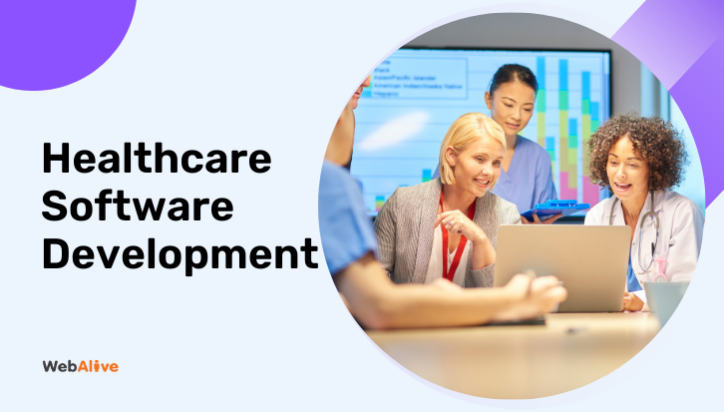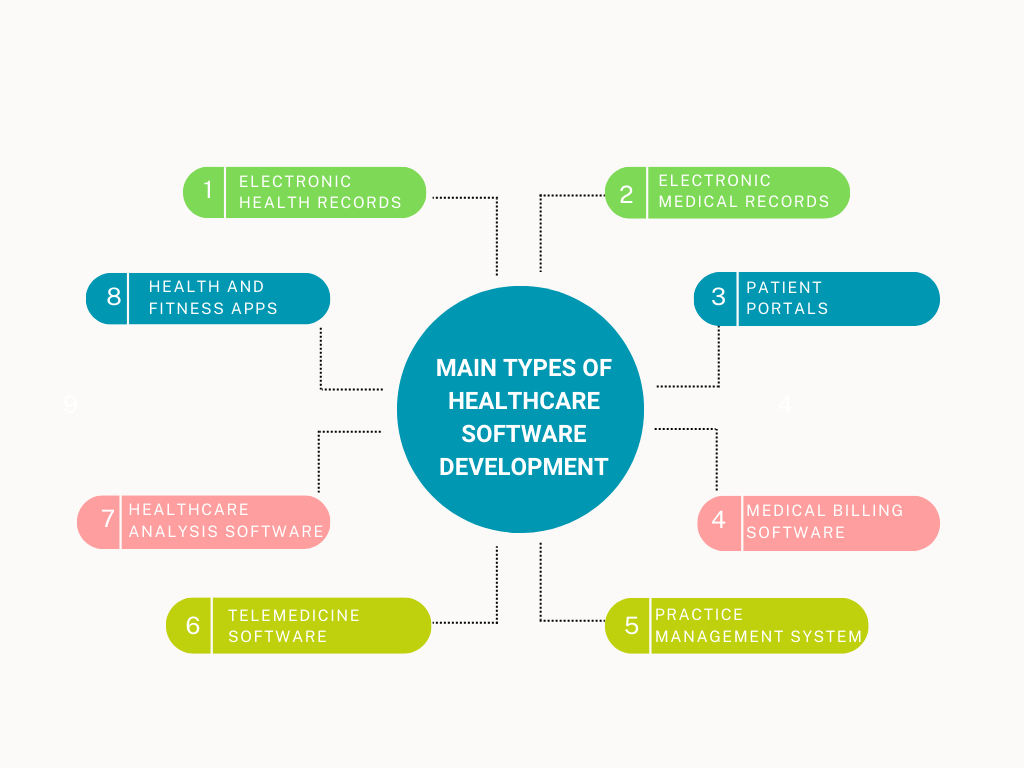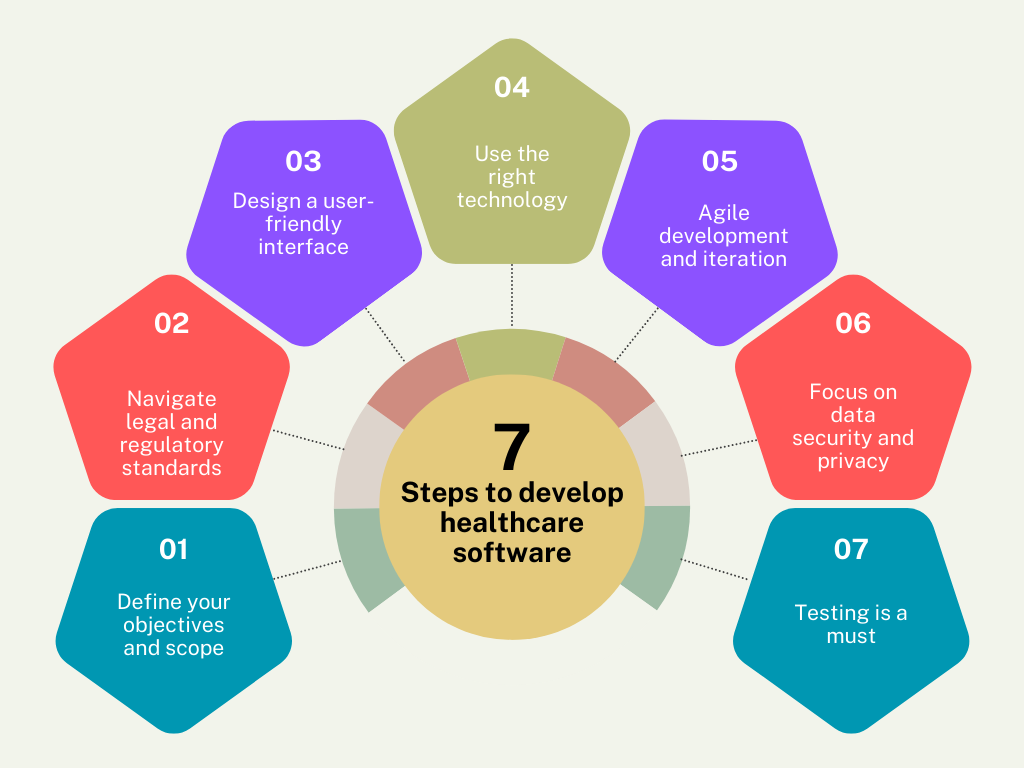
Healthcare Software Development: A Complete Guide for 2025
Healthcare software eventually refers to a range of digital applications and tools that are particularly designed to improve medical services, streamline tasks and enhance patient care. Some of the key functions of healthcare software include patient monitoring, clinical support, data analysis, patient engagement and more.
According to a report by Precedence Research, the global healthcare software that accounted for USD 34.84 billion in 2024 is expected to grow to USD 38.50 billion in 2025 and is predicted to surpass USD 94.56 billion by 2034.
If we note down some of the factors behind the rapid growth of this market, there will be the increasing usage of smartphones, the growing demand for remote patient monitoring, technological advancement in healthcare IT infrastructure including SaaS, cloud computing, wearable technology, telemedicine and more.
8 Main types of healthcare software development

1. Electronic health records
Electronic health records software is designed to store and manage patient information digitally. It is used to offer centralised access to healthcare providers where they can get comprehensive medical histories. From patient demographics to medical history to medication lists to lab results, the features include everything.
2. Electronic medical records
Electronic medical records software is used to maintain digital records for individual practices or healthcare facilities. It is primarily used by a single organisation for managing clinical workflows including charting, treatment notes and lap tracking.
3. Patient portals
Patient portals are web-based platform that let patient to access their health information, manage appointments or even communicate. It can be any sort of information, including test results, medication histories and more. Advanced features such as teleconsultation, payment gateways and personalised health tips can also be available in custom patient portals.
4. Medical billing software
This sort of software helps in automating the complex process of healthcare billing. It ensures accuracy and compliance with insurance regulations by simplifying claiming processing, tracking payments and generating detailed financial reports.
5. Practice management system
Practice management systems are designed in a way so that it can handle the administrative and operational aspects. The system usually includes scheduling, patient registration, billing and reporting functionalities.
6. Telemedicine software
Telemedicine software enables remote consultations. It makes healthcare accessible to patients regardless of location. From video conferencing to appointment scheduling to secure patient-provider communication, the features include everything.
7. Healthcare analysis software
Healthcare analysis software uses data analytics to provide insights such as patient care, operational efficiency and financial performance. Advanced features like predictive analytics and AI-driven recommendations also boost the management system.
8. Health and fitness apps
This software is mostly used to cater to individual users, promoting wellness and healthy living. The app includes features such as workout tracking, nutrition guidance, sleep monitoring and step counting.
7 Steps to Develop Healthcare Software
Let’s walk through the essential steps involved in developing healthcare software.

1. Define your objectives and scope
This is a foundational step. Before you dive into development, it is better to have a clear understanding of what you want to achieve. In this step, you should take time to lay out the key features and functionalities of your software.
2. Navigate legal and regulatory standards
Healthcare software needs to adhere to strict regulations to protect patient data and privacy. For example, you need to comply with laws like HIPAA (Health Insurance Portability and Accountability Act), or GDPR (General Data Protection Regulation).
3. Design a user-friendly interface
Considering ease of use and accessibility, your software needs to be intuitive enough for everyone. The design has to be good enough so that a doctor who has minimum tech experience can use your app to view patient records quickly.
4. Use the right technology
The success of any software largely depends on the technology behind it. So, select the right programming languages, frameworks and tools to ensure scalability, security and seamless functionality. You need to make sure that your software is capable enough to handle large amounts of data.
5. Agile development and iteration
Software development is not a one-and-done process. So, it is wiser to use agile development as it allows for iterative updates and improvements. You can continue the development process in short, manageable cycles so that you can release updates regularly.
6. Focus on data security and privacy
When developing healthcare software, security should be the top priority. Healthcare data is very sensitive. It will work best if you incorporate features like multi-factor authentication and role-based access control.
7. Testing is a must
Before you launch your software, make sure every feature is working as expected. Test your software properly for any sort of vulnerabilities to make sure that it is resistant to cyber threats. Alongside functional testing, run compliance testing and usability testing as well.
Key trends that are shaping healthcare software development in 2025
AI is a leading healthcare tech trend
AI is used in healthcare to:
- Analyse medical images and patient data
- Automate administrative tasks
- Treat neurotic disorders
- Track real-time patient health metrics
- Accelerate drug research
Blockchain technology is emerging as a vital tool to ensure the privacy of healthcare data.
Blockchain technology is used in healthcare to:
- Protect sensitive patient information
- Reduce fraud and errors in medical billing
- Track pharmaceuticals and medical supplies
- Securely share anonymised patient data
The IoMT ecosystem is rapidly expanding
The IoMT ecosystem is used in healthcare to:
- Monitor patient health in real-time
- Streamline chronic disease management
- Enable remote patient care with devices
- Support telemedicine services
Telemedicine has become an indispensable part
Telemedicine is used in healthcare to:
- Facilitate virtual consultations
- Provide remote monitoring
- Reduce patient travel time and associated healthcare costs
- Enable access to healthcare in any areas
Interoperability remains a cornerstone of effective healthcare software
Interoperability is used in healthcare to:
- Enable seamless sharing of patient data
- Minimise medical errors
- Support better decision-making
- Improve care coordination
Final words
Overall, if you want to make a strategic investment in your organisation’s success, choose the right healthcare software developer. After all, creating healthcare software isn’t just about writing code. Working with a skilled developer will ensure that your software is compliant, secure, scalable, and user-friendly. So, it is not just beneficial, it is essential.
You read a lot. We like that
Want to take your online business to the next level? Get the tips and insights that matter.

